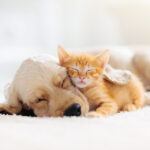Your home is your sanctuary, but if you’re a pet owner, it’s important to remember that your furry friends need a safe and secure environment too. From curious cats to playful dogs, pets can unknowingly get themselves into trouble. That’s why pet-proofing your home is crucial. In this guide, we’ll explore how to identify potential hazards, secure harmful items, and create a safe space for your pets.
Identifying Potential Hazards Around the Home
Living Room
- Cables and cords: Pets love to chew, and electrical cords can be especially tempting. Use cable management solutions to keep cords out of reach.
- Houseplants: Some plants are toxic to pets. Check your plants and ensure they are safe for your furry friends.
- Small objects: Items like batteries, coins, and small toys can be choking hazards. Keep these items in secure places.
Kitchen
- Food hazards: Many human foods are toxic to pets, including chocolate, grapes, and onions. Store food in cabinets or the refrigerator.
- Cleaning supplies: Chemicals can be dangerous if ingested. Store all cleaning supplies in a locked cabinet.
- Trash bins: Pets can easily knock over trash bins and ingest harmful items. Use a pet-proof trash can with a secure lid.
Bathroom
- Medications: Keep all medications, including over-the-counter drugs, in a locked cabinet.
- Toiletries: Items like razors, soaps, and lotions can be harmful if ingested. Store these items out of reach.
- Toilet bowl: Close the toilet lid to prevent pets from drinking potentially harmful water.
Securing Household Items and Chemicals
Pet Gates and Locks
- Pet gates can keep pets out of restricted areas. They’re especially useful for keeping pets out of the kitchen or baby’s room.
- Childproof locks on cabinets can prevent pets from accessing harmful chemicals and foods.
High Shelves
- Use high shelves to store items that could be dangerous if ingested, such as medications, cleaning supplies, and small objects.
Pet-Proofing Both Indoor and Outdoor Spaces
Don’t forget about the great outdoors! Your yard can also pose risks to your pets.
Indoor Safety
- Secure windows and balconies to prevent falls.
- Ensure that furniture is stable and won’t tip over if your pet jumps on it.
- Create a designated pet area where they can relax and feel safe.
Outdoor Safety
- Fencing should be secure and high enough to prevent pets from escaping.
- Be cautious of toxic plants and pesticides in your garden.
- Provide shade and water to keep pets comfortable during hot weather.
Creating a Safe and Comfortable Space When Pets are Home Alone
When you’re not at home, it’s essential that your pet has a safe and comfortable space.
- Crate training can provide a secure area for your pet when you’re not around.
- Leave out toys and puzzles to keep them entertained and mentally stimulated.
- Ensure they have access to fresh water and a comfortable place to rest.
Final Thoughts
Pet-proofing your home is a simple yet effective way to ensure the safety and well-being of your furry friends. By identifying potential hazards, securing harmful items, and creating safe spaces both indoors and outdoors, you can prevent accidents and give your pets the best environment to thrive in.
If you have any questions or need further advice on pet-proofing your home, don’t hesitate to contact Tipp City Veterinary Hospital. We’re here to help with all your pet needs.
Contact Tipp City Veterinary Hospital today to schedule a pet-proofing consultation or to address any concerns you may have about your pet’s safety at home. Visit our website or call us to get started.






